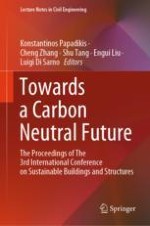2024 | OriginalPaper | Buchkapitel
Consideration on Carbon Emission of Existing Buildings in the Stage of Ultra-Low Energy Consumption Reconstruction
verfasst von : Xiu Han, Jinghua Shen
Erschienen in: Towards a Carbon Neutral Future
Verlag: Springer Nature Singapore
Aktivieren Sie unsere intelligente Suche, um passende Fachinhalte oder Patente zu finden.
Wählen Sie Textabschnitte aus um mit Künstlicher Intelligenz passenden Patente zu finden. powered by
Markieren Sie Textabschnitte, um KI-gestützt weitere passende Inhalte zu finden. powered by
